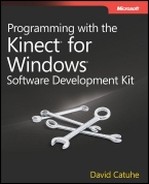I am always impressed when science fiction and reality meet. With Kinect for Windows, this is definitely the case, and it is exciting to be able to control the computer with only our hands, without touching any devices, just like in the movie “Minority Report.”
I fell in love with Kinect for Windows the first time I tried it. Being able to control my computer with gestures and easily create augmented reality applications was like a dream come true for me. The ability to create an interface that utilizes the movements of the user fascinated me, and that is why I decided to create a toolbox for Kinect for Windows to simplify the detection of gestures and postures.
This book is the story of that toolbox. Each chapter allows you to add new tools to your Kinect toolbox. And at the end, you will find yourself with a complete working set of utilities for creating applications with Kinect for Windows.
Kinect for Windows offers an extraordinary new way of communicating with the computer. And every day, I see plenty of developers who have great new ideas about how to use it—they want to set up Kinect and get to work.
If you are one of these developers, this book is for you. Through sample code, this book will show you how the Kinect for Windows Software Development Kit works–and how you can develop your own experience with a Kinect sensor.
For the sake of simplification, I use C# as the primary language for samples, but you can use other .NET languages or even C++ with minimal additional effort. The sample code in this book also uses WPF 4.0 as a hosting environment. This book expects that you have at least a minimal understanding of C#, WPF development, .NET development, and object-oriented programming concepts.
This book is focused on providing the reader with sample code to show the possibilities of developing with the Kinect for Windows SDK, and it is clearly written for developers, by a developer. If you are not a developer or someone with coding skills, you might consider reading a more introductory book such as Start Here! Learn the Kinect API by Rob Miles (Microsoft Press, 2012).
This book is divided into four sections. Part I provides a quick tour of Kinect for Windows SDK and describes how it works. Part II shows you how to develop tools to integrate Kinect seamlessly into your own applications. Part III focuses on how to develop a rich postures and gestures recognition system. Finally, Part IV covers the use of Kinect as a new input mechanism and describes how you can create an augmented reality application.
The different sections cover a wide range of technologies associated with the Kinect for Windows SDK. Depending on your needs and your familiarity with Kinect, you may want to focus on specific areas of the book. Use the following table to determine how best to proceed through the book.
If you are | Start reading |
|---|---|
New to Kinect for Windows development | |
Familiar with Kinect and interested in gestures and postures development |
Most of the book’s chapters include hands-on samples that let you try out the concepts just learned. No matter which sections you choose to focus on, be sure to download and install the sample applications on your system.
You will need the following hardware and software to use the code presented in this book:
Windows 7 or Windows 8 (32-bit or 64-bit edition)
Microsoft Visual Studio 2010 Express or other Visual Studio 2010 edition
.NET Framework 4 (installed with Visual Studio 2010)
XNA Game Studio 4
32-bit (x86) or 64-bit (x64) processors
Dual-core, 2.66-GHz or faster processor
USB 2.0 bus dedicated to the Kinect
2 GB of RAM
Graphics card that supports DirectX 9.0c
Kinect for Windows sensor
Depending on your Windows configuration, you might require Local Administrator rights to install or configure Visual Studio 2010.
Most of the chapters in this book include code samples that let you interactively try out new material learned in the main text. All sample projects can be downloaded from the following page:
Follow the instructions to download the KinectToolbox.zip file.
Follow these steps to install the code samples on your computer so that you can use them with the exercises in this book.
Unzip the KinectToolbox.zip file that you downloaded from the book’s website (name a specific directory along with directions to create it, if necessary).
If prompted, review the displayed end user license agreement. If you accept the terms, select the accept option, and then click Next.
I’d like to thank the following people: Devon Musgrave for giving me the opportunity to write this book. Dan Fernandez for thinking of me as a potential author for a book about Kinect. Carol Dillingham for her kindness and support. Eric Mittelette for encouraging me from the first time I told him about this project. Eric Vernié, my fellow speaker in numerous sessions during which we presented Kinect.
We’ve made every effort to ensure the accuracy of this book and its companion content. Any errors that have been reported since this book was published are listed on our Microsoft Press site at oreilly.com:
If you find an error that is not already listed, you can report it to us through the same page.
If you need additional support, email Microsoft Press Book Support at [email protected].
Please note that product support for Microsoft software is not offered through the addresses above.
At Microsoft Press, your satisfaction is our top priority, and your feedback our most valuable asset. Please tell us what you think of this book at:
The survey is short, and we read every one of your comments and ideas. Thanks in advance for your input!
Let’s keep the conversation going! We’re on Twitter: http://twitter.com/MicrosoftPress.
